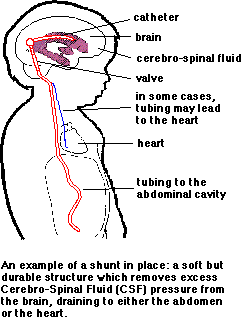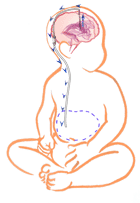There are two main types of hydrocephalus: congenital or acquired.
The former means that the problem existed at birth, although it may
not noticeably manifest itself until later in life, perhaps even adulthood.
The latter means that the root cause of the hydrocephalus,
whether it is head trauma, tumor or infection, occurred after birth.
Aqueductal Obstruction , or Stenosis ,
is the most common cause of congenital hydrocephalus.
The cerebral aqueduct, which conducts
CSF from the third to the fourth ventricle, is blocked due to defect,
inflammation, tumor or hemorrhage.
This forces CSF fluid to back up, thereby causing hydrocephalus.
Neural Tube Defects occur when the surrounding and supporting structure of the spinal cord,
not the spinal cord itself, is defective or not fully developed.
This malformation can create a blockage in the opening at the base of the skull,
which in turn retards the flow of CSF from the fourth ventricle.
Intraventricular Hemorrhage occurs most frequently in premature babies
whose blood vessels in the brain have not been able to fully develop.
Because of this weakness, the vessels can burst,
thereby allowing the blood to block or scar the ventricles of the CSF pathways.
Meningitis , whether viral or bacterial in origin,
causes inflammation of the membranes surrounding the brain and spinal cord.
Scarring of these membranes may restrict the flow of CSF and lead to
the onset of hydrocephalus.
In cases where Head Trauma occurs, blood from ruptured vessels may lead to
inflammation and scarring of the brain membranes, or can even block the absorption of CSF into tissue.
If these CSF flow restrictions occur, hydrocephalus develops.
Tumors may grow in the brain and compress areas of the ventricular system,
thereby restricting the flow of CSF and leading to the onset of hydrocephalus.
Arachnoid Cysts , or cysts made up of CSF-filled arachnoid membrane,
may block the CSF pathways and bring on hydrocephalus.
This condition is congenital and may occur anywhere in the brain.
In instances of Dandy-Walker Syndrome ,
a congenital defect, the fourth ventricle is enlarged and its outlets become obstructed.
Because the flow of CSF throughout the brain is obstructed,
hydrocephalus develops.
Normal Pressure Hydrocephalus (NPH), a form of hydrocephalus that typically affects the elderly.
NPH is usually characterized by complaints of gait disturbance
(difficulty walking), mild dementia, and urinary incontinence
Text from Medtronics
|

